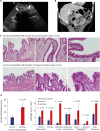Association of Microbial Dysbiosis with Gallbladder Diseases Identified by Bile Microbiome Profiling
- PMID: 34282606
- PMCID: PMC8289718
- DOI: 10.3346/jkms.2021.36.e189
Association of Microbial Dysbiosis with Gallbladder Diseases Identified by Bile Microbiome Profiling
Abstract
Background: Cholecystitis is an important risk factor for gallbladder cancer, but the bile microbiome and its association with gallbladder disease has not been investigated fully. We aimed to analyze the bile microbiome in normal conditions, chronic cholecystitis, and gallbladder cancer, and to identify candidate bacteria that play an important role in gallbladder carcinogenesis.
Methods: We performed metagenome sequencing on bile samples of 10 healthy individuals, 10 patients with chronic cholecystitis, and 5 patients with gallbladder cancer, and compared the clinical, radiological, and pathological characteristics of the participants.
Results: No significant bacterial signal was identified in the normal bile. The predominant dysbiotic bacteria in both chronic cholecystitis and gallbladder cancer were those belonging to the Enterobacteriaceae family. Klebsiella increased significantly in the order of normal, chronic cholecystitis, and gallbladder cancer. Patients with chronic cholecystitis and dysbiotic microbiome patterns had larger gallstones and showed marked epithelial atypia, which are considered as precancerous conditions.
Conclusion: We investigated the bile microbiome in normal, chronic cholecystitis, and gallbladder cancer. We suggest possible roles of Enterobacteriaceae, including Klebsiella, in gallbladder carcinogenesis. Our findings reveal a possible link between a dysbiotic bile microbiome and the development of chronic calculous cholecystitis and gallbladder cancer.
Keywords: Bile; Chronic Cholecystitis; Gallbladder Diseases; Gallbladder Neoplasms; Microbiota.
© 2021 The Korean Academy of Medical Sciences.
Conflict of interest statement
The authors have no potential conflicts of interest to disclose.
Figures





Similar articles
-
Metagenomic Analysis of Biliary Microbial Flora in Patients with Gallbladder Cancer or Gallstones-Associated Chronic Cholecystitis.Cancer Invest. 2024 Jul;42(6):478-490. doi: 10.1080/07357907.2024.2361305. Epub 2024 Jun 7. Cancer Invest. 2024. PMID: 38845533
-
[Microbiological study of gallbladder bile in a high risk zone for gallbladder cancer].Rev Med Chil. 1999 Sep;127(9):1049-55. Rev Med Chil. 1999. PMID: 10752267 Spanish.
-
The human gallbladder microbiome is related to the physiological state and the biliary metabolic profile.Microbiome. 2019 Jul 4;7(1):100. doi: 10.1186/s40168-019-0712-8. Microbiome. 2019. PMID: 31272480 Free PMC article.
-
[The morphology, microbiology and ultrasonic diagnosis of calculous cholecystitis].Lik Sprava. 1998 Dec;(8):10-4. Lik Sprava. 1998. PMID: 10204337 Review. Russian. No abstract available.
-
Infection as a risk factor for gallbladder cancer.J Surg Oncol. 2006 Jun 15;93(8):633-9. doi: 10.1002/jso.20530. J Surg Oncol. 2006. PMID: 16724347 Review.
Cited by
-
Microbiota and Radiotherapy: Unlocking the Potential for Improved Gastrointestinal Cancer Treatment.Biomedicines. 2025 Feb 19;13(2):526. doi: 10.3390/biomedicines13020526. Biomedicines. 2025. PMID: 40002939 Free PMC article. Review.
-
Characteristics of gallbladder microbiome in healthy dogs and cats, dogs with gallbladder mucocele, and cats with suspected cholangitis/cholangiohepatitis.Can J Vet Res. 2024 Jul;88(3):77-86. Can J Vet Res. 2024. PMID: 38988335 Free PMC article.
-
Microbial profile in bile from pancreatic and extra-pancreatic biliary tract cancer.PLoS One. 2024 Feb 21;19(2):e0294049. doi: 10.1371/journal.pone.0294049. eCollection 2024. PLoS One. 2024. PMID: 38381746 Free PMC article.
-
Profiles of biliary microbiota in biliary obstruction patients with Clonorchis sinensis infection.Front Cell Infect Microbiol. 2023 Dec 18;13:1281745. doi: 10.3389/fcimb.2023.1281745. eCollection 2023. Front Cell Infect Microbiol. 2023. PMID: 38164415 Free PMC article.
-
Survival Strategies and Metabolic Interactions between Ruminococcus gauvreauii and Ruminococcoides bili, Isolated from Human Bile.Microbiol Spectr. 2022 Aug 31;10(4):e0277621. doi: 10.1128/spectrum.02776-21. Epub 2022 Jul 11. Microbiol Spectr. 2022. PMID: 35863028 Free PMC article.
References
-
- Ferlay JE, Lam F, Colombet M, Mery L, Piñeros M, Znaor A, et al. Global cancer observatory: cancer today. [Updated 2020]. [Accessed March 20, 2020]. https://gco.iarc.fr/today.
-
- Yamaguchi K, Chijiiwa K, Saiki S, Nishihara K, Takashima M, Kawakami K, et al. Retrospective analysis of 70 operations for gallbladder carcinoma. Br J Surg. 1997;84(2):200–204. - PubMed
-
- Boutros C, Gary M, Baldwin K, Somasundar P. Gallbladder cancer: past, present and an uncertain future. Surg Oncol. 2012;21(4):e183–e191. - PubMed
-
- Nath G, Singh H, Shukla VK. Chronic typhoid carriage and carcinoma of the gallbladder. Eur J Cancer Prev. 1997;6(6):557–559. - PubMed
MeSH terms
Grants and funding
LinkOut - more resources
Full Text Sources
Medical

